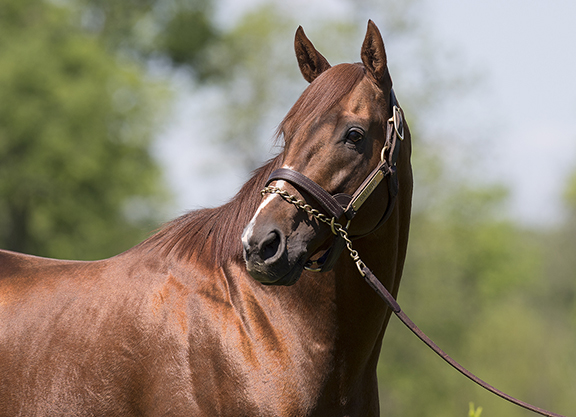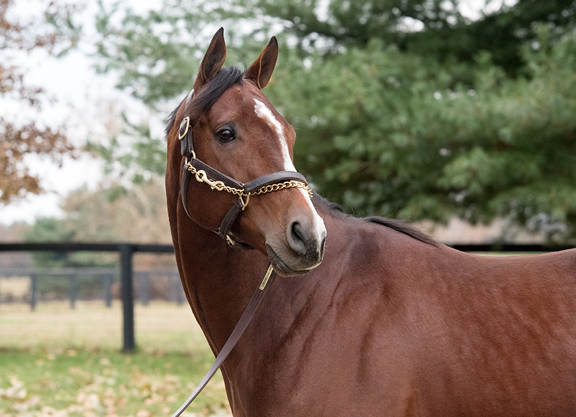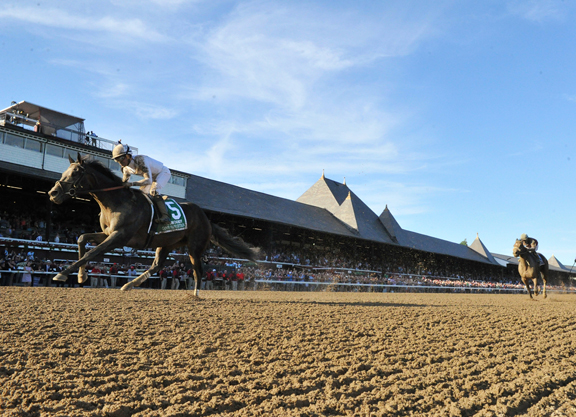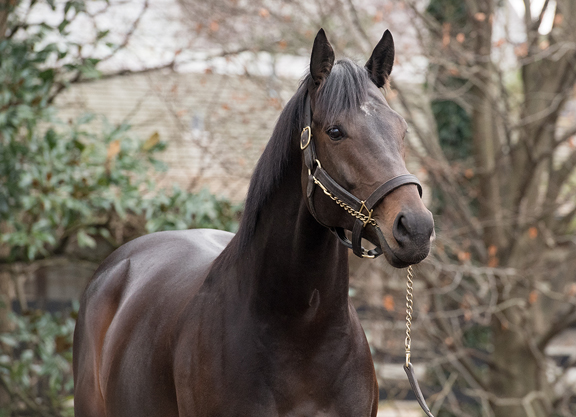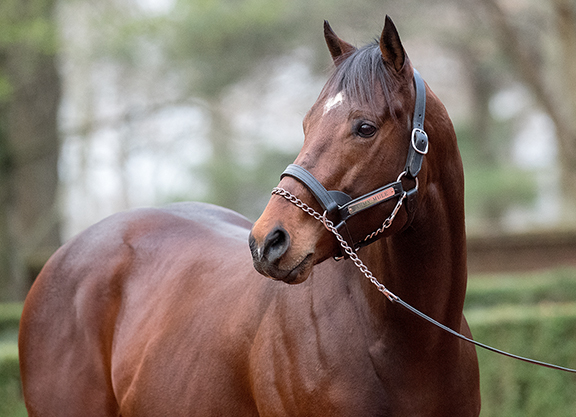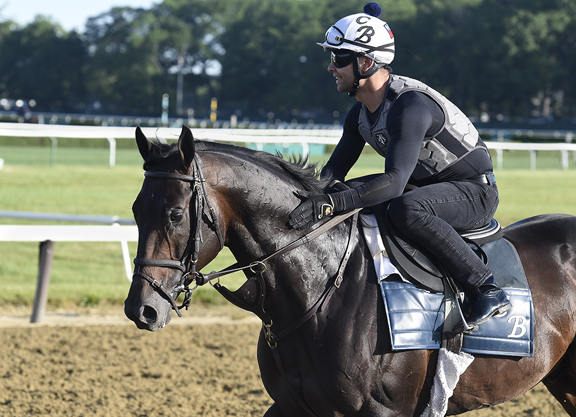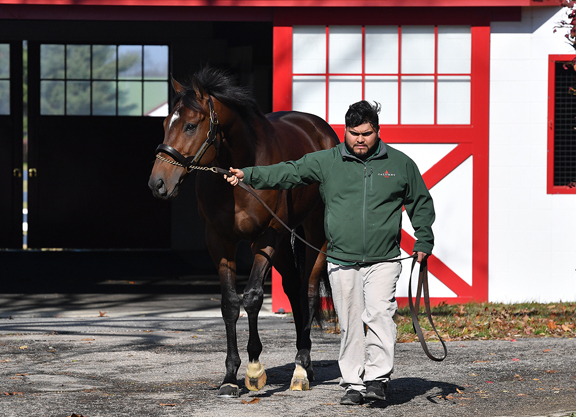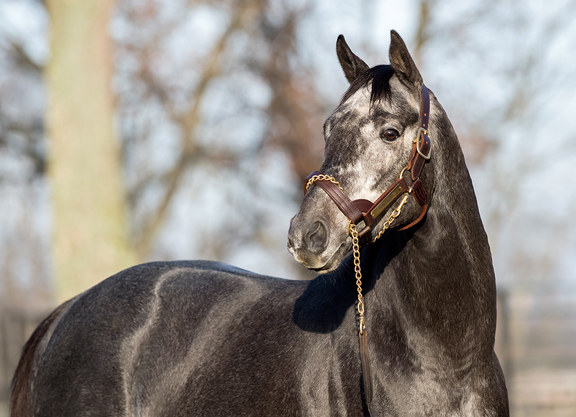In the third installation of our Value Sires series, we will dig into the sire crop with its first foals born in 2020, and therefore with its first yearlings this year. After some two years in waiting since most of these retired to stud, the judges got the chance at the recently concluded foal sales to lay eyes on the first progeny of most of them, and though it is still incredibly early days, their opinions, corroborated through their actions in the ring, will have an impact on the perception of these horses and the support they receive in their crucial third and fourth seasons.
It is interesting to note that the top four first-season sires by average at the European foal sales in 2020 were all born abroad, and are all by sires that stand outside Europe. It’s not like any of them have snuck up on us, of course-Saxon Warrior (Jpn) (Deep Impact {Jpn}), Roaring Lion (Kitten’s Joy), Zoustar (Aus) (Northern Meteor {Aus}) and US Navy Flag (War Front) were four of the top five most expensive horses of their crop to retire to stud in 2019. But it is affirmation of the global nature of the game.
We noted in our prior edition of Value Sires that all bar three of the 18 sires with their first foals to be born in 2021 are taking fee cuts, and the nature of the pandemic and the global economic uncertainty means of course that much of this sire crop, too, has had its fees reduced.
Leading the way on first-crop foal sale averages was Coolmore’s G1 Racing Post Trophy and G1 2000 Guineas winner Saxon Warrior, who had 16 sold for an average of €108,315/£98,679-3.6x his debut stud fee of €30,000, and he was the only member this sire crop to crack six figures on foal sale averages. His median of €82,502/£75,162 was 2.75x his fee. Saxon Warrior had 94 foals registered from his first crop and covered a further 166 mares last year at a fee of €27,500, and he stands for €20,000 in 2021.
Unbeaten in three starts at two, Saxon Warrior won the G2 Beresford S. before besting Roaring Lion in the Racing Post Trophy. He once again bettered that rival as well as the likes of Derby winner Masar (Ire) (New Approach {Ire}) and GI Breeders’ Cup Mile victor Expert Eye (GB) (Acclamation {GB}) in the Guineas first up at three. Though that proved his final win, Saxon Warrior put in fine performances in some of Europe’s greatest races over the remainder of the summer, including second-place finishes by a neck to Roaring Lion in both the G1 Coral-Eclipse and G1 Irish Champion S. Saxon Warrior is the second foal out of the G1 Moyglare Stud S.-winning and Classic-placed Maybe (Ire) (Galileo {Ire}) who, after a stint in America to visit American Pharoah and War Front, returned to Japan and produced a full-brother to Saxon Warrior in 2020. Maybe is herself out of Sumora (Ire) (Danehill), a three-quarter-sister to G1 Oaks winner and multiple stakes producer Dancing Rain (Ire) (Danehill Dancer {Ire}), while sires Dr Devious (Ire) and Shinko King (Ire) and last year’s G1 Irish Oaks winner Even So (Ire) (Camelot {GB}) appear under the third dam.
Second on the first-crop foal sale averages was Horse of the Year Roaring Lion, who tragically died in the summer of 2019 after covering a book of 133 mares that resulted in 90 registered foals for a fee of £40,000 at Tweenhills Stud. Roaring Lion’s eight foals sold at the sales averaged €69,603/€63,411, with a median of €62,272/£56,732. While his legacy will be sadly fleeting, he nonetheless has an excellent chance to make a last impact, with Group 1 winners Bateel (Ire) (Dubawi {Ire}), Giofra (GB) (Dansili {GB}), Golden Lilac (Ire) (Galileo {Ire}) and Simple Verse (GB) (Duke of Marmalade {Ire}) among those to have produced by him, as well as excellent young mares like Kiyoshi (GB) (Dubawi {Ire}), Purr Along (GB) (Mount Nelson {GB}) and Wekeela (Fr) (Hurricane Run {Ire}).
The team at Tweenhills are afforded some consolation by the fact that they have another exciting young sire among this group, the Australian shuttler Zoustar (Aus) (Northern Meteor {Aus}). Zoustar’s popularity in his first season shuttling was such that he sired 102 foals in his first crop, and he covered a further 124 mares last year. Zoustar started at £25,000 in 2019, took a rare second-season fee hike last year to £30,000 and is back down to £25,000 in 2021. His 18 first-crop foals sold at the breeding stock sales averaged €67,281/£61,295, 2.7x his stud fee, with a median of €49,971/£45,525, 2x his stud fee.
The team at Qatar Bloodstock, which had bought into Zoustar during his racing career, made the strategic decision to not shuttle the horse until he had proven himself Down Under, and that decision has paid dividends, with Zoustar having an excellent body of work behind him in his homeland before he even set foot on UK soil. Zoustar won two key sire-making races in Australia, the G1 Golden Rose S. and G1 Coolmore Stud S., over seven and six furlongs at three, and it took him no time at all to fulfill that prophecy in the stud barn. He was far and away the leading first- and second-crop sire of his generation in Australia, and in his first season among the general sire ranks in 2019/20 wound up seventh with just three crops of racing age. Zoustar thus far has 16 stakes winners with his fourth crop of juveniles having just hit the racetracks Down Under, with 12 of those emanating from his first crop including his brilliant sprinting mare Sunlight (Aus), who led home a trifecta for her sire in the Coolmore Stud S. of 2018. Sunlight is one of five pattern race winners by Zoustar with dams or second dams by Sadler’s Wells or Danehill, which bodes well for the European broodmare population.
European breeders may be less familiar with Zoustar’s sire Northern Meteor-another winner of the Coolmore Stud S. who got off to a brilliant start at stud before an untimely death. He is a son of the excellent Australian sire Encosta de Lago (Aus), who is by Sadler’s Wells’s full-brother Fairy King, and out of a daughter of the influential American sire Fappiano. European breeders will be plenty familiar, however, with Zoustar’s damsire Redoute’s Choice (Aus), who not only hails from one of the most international families in the stud book but who is himself proven in the Northern Hemisphere through the likes of G1 Grosser Dallmayr Preis winner Danceteria and the excellent staying filly Enbihaar, the winner of five Group 2s.
Like Zoustar, US Navy Flag started out at €25,000 at Coolmore in 2019, and after dropping to €17,500 last year he is down to €12,500 for 2021. US Navy Flag’s 10 foals to sell at the sales last year averaged €39,971/£36,415, with a median of €41,297/£37,623. Like Saxon Warrior, US Navy Flag is out of a Group 1-winning daughter of Galileo, his dam being the four-time Group 1 and Classic winner Misty For Me (Ire), a full-sister to the G1 Prix Marcel Boussac scorer Ballydoyle (Ire) who has also produced the triple Group 1 winner Roly Poly (War Front). US Navy Flag’s second dam, Butterfly Cove (Storm Cat), is a half-sister to the dual Group 1-winning juvenile and sire Fasliyev (Nureyev).
US Navy Flag embodied the precocity his pedigree suggested he should. He ran a remarkable 11 times at a 2-year-old, finishing worse than fourth just twice and winning the G1 Middle Park S. and the G1 Dewhurst S. over his subsequent GI Breeders’ Cup Juvenile Turf-winning stablemate Mendelssohn (Scat Daddy). US Navy Flag returned at three to win the G1 July Cup in a performance that was a joint career-best with his Dewhurst win (RPR 122). He sired 60 first-crop foals last year and covered an additional 143 mares in his second book.
Darley’s Champions
Rounding out the top five first-crop sires by average at the foal sales last year was Darley’s Cracksman (GB) (Frankel {GB}), who had 16 foals sell for an average of €35,958/£32,759. Cracksman has stood for £25,000 the past two seasons and is down to £17,500 for 2021.
Cracksman has earned the gold medal on the value sire podium in this column the past two years based on his racetrack merits; he was one of the best racehorses we’ve seen in the past 10 years, his official rating of 130 trailing only Frankel (140), Sea The Stars (Ire) (136) and Harbinger (135) among European colts in the past decade.
A debut winner in October of his 2-year-old campaign, Cracksman won an Epsom Derby trial conditions race next out before finishing a length off Wings Of Eagles (Fr) (Pour Moi {Ire}) when third in the Derby in his third start. He split that rival and the winning Capri (Ire) (Galileo {Ire}) in the G1 Irish Derby before embarking on a three-race win streak that began with the G2 Great Voltigeur S. and G2 Prix Niel and culminated in a seven-length score in the G1 Champion S. (RPR 131), good enough to earn him champion 3-year-old honours at the Cartier awards.
Cracksman added victories in the G1 Prix Ganay and G1 Coronation Cup and a title defense in the G1 Champion S.-in which he won by six lengths, equaling his RPR of 131 from the year prior-at four. He packs plenty of power on pedigree, too, being out of the stakes-winning and multiple stakes-producing Pivotal (GB) mare Rhadegunda (GB), who is herself a granddaughter of the G1 1000 Guineas and G1 Sussex S. scorer On The House (Be My Guest). Cracksman sired 98 first-crop foals last year and covered 112 mares in his second book.
Cracksman is joined at Dalham Hall by another Cartier champion in Harry Angel (Ire) (Dark Angel {Ire}). A half-brother to the G2 Mill Reef S. victor Pierre Lapin (Ire) (Cappella Sansevero {GB}) out of Beatrix Potter (Ire) (Cadeaux Genereux {GB}), a half-sister to Hong Kong star Xtension (Ire) (Xaar {GB}), Harry Angel was a sprinter of the highest quality. He also won the Mill Reef at two and leapt into the big leagues at three with back-to-back scores in the G1 July Cup and G1 Sprint Cup. Harry Angel has had 89 foals reported from his first crop and bred an additional 98 mares last year. After standing for £20,000 his first two seasons, Harry Angel is down to £12,500.
Expert Selection
Another young Group 1 winner who has been well supported is Juddmonte’s GI Breeders’ Cup Mile scorer Expert Eye (GB) (Acclamation {GB}), who has 96 first-crop foals and covered 105 mares in his second book including a handful of Juddmonte bluebloods. Expert Eye was precocious enough to win the G2 Vintage S. at two, and add the G3 Jersey S. at Royal Ascot by 4 1/2 lengths and the G3 City Of York S. before shipping to Churchill Downs to take the Breeders’ Cup Mile. There have been fewer sire lines hotter than Acclamation as of late, he having supplied the likes of Dark Angel and Mehmas (Ire), and Expert Eye has the female side to match; his dam Exemplify (GB) (Dansili {GB}) is a half-sister to champion and dual Classic winner Special Duty (GB) (Hennessy), and it is also the family of multiple Grade I winners Sightseek (Distant View) and Tates Creek (Rahy). Expert Eye is down to £12,500 after standing for £20,000 and £17,500, with his first-crop foals (22 sold) having averaged €35,857/£32,667.
Completing the Coolmore clan with its first yearlings in 2021 are the Castlehyde Stud duo of Sioux Nation (Scat Daddy) and Gustav Klimt (Ire) (Galileo {Ire}). Sioux Nation shares a likeness with No Nay Never not only through their sire by also through the fact that they both won the G2 Norfolk S. at two and followed it up with a Group 1 score; for No Nay Never it was the Prix Morny, and for Sioux Nation it was the Phoenix S. Both also trained on to win Group 3 sprints at three, and Sioux Nation was just three quarters of a length behind Havana Grey (GB) (Havana Gold {Ire}) when third in the G1 Flying Five S. Sioux Nation was the busiest first-season flat sire in Britain and Ireland last year, covering 241 mares which yielded a first crop of 133 foals. His second book numbered 158 mares. Sioux Nation was well received at the foal sales, his 28 sold averaging €29,622/£26,987, 2.4x his opening stud fee of €12,500. Sioux Nation, who is out of the Oasis Dream (GB) mare Dream The Blues (Ire), is down to €10,000 for 2021.
Gustav Klimt hails from the same Galileo over Danehill cross that has produced the excellent sires Frankel and Teofilo. His race record didn’t nearly hit the heights of either of those two, but nonetheless he won the G2 Superlative S. at two and, in addition to taking the Listed 2000 Guineas Trial S. at Leopardstown at three, placed in the G1 Irish 2000 Guineas, the G1 St James’s Palace S., G1 Prix Jean Prat and G1 Sprint Cup during a busy 10-race 3-year-old campaign. Gustav Klimt has a sire’s pedigree, too, being out of Massarra (GB), who has produced five stakes winners and is herself a daughter of Rafha (GB) (Kris {GB}), the dam of Invincible Spirit (Ire) and Kodiac (GB). It is also the family of Pride Of Dubai (Aus), who made an eye-catching start with his first 2-year-olds last year, and future sire power could be added to the page by not only Gustav Klimt but also Pinatubo (Ire), who is the most expensive first-season sire of 2021, and James Garfield (Ire) (Exceed and Excel {Aus}), who also stands his second season in 2021. Gustav Klimt is down to €4,000 after standing for €7,500 and €6,500 the past two seasons.
Rathbarry Stud’s James Garfield bested Invincible Army (Ire) (Invincible Spirit {Ire}) in the G2 Mill Reef S. in 2017 and trained on to beat Expert Eye (GB) (Acclamation {GB}) in the G3 Greenham S. before being beaten a half-length in the G1 Prix Maurice de Gheest. He had 45 first-crop foals last year before covering another 31 mares and is down to €4,000 from an opening fee of €7,000.
Speed Proves Popular
Whitsbury Manor Stud’s Havana Grey (GB) (Havana Gold {Ire}) was the busiest of this sire crop at the foal sales last year, with 44 offered and 36 sold for an average of €26,161/£23,834 (3.3x his opening fee of £8,000) and a median of €18,812/£17,139. His first crop numbered 108 foals, and he maintained his popularity when covering a further 130 mares in 2020 dropped to £6,500. He is available for £6,000 this year. From the family of the great Al Bahathri (Blushing Groom {Fr}) and her sire son Haafhd (GB) (Alhaarth {Ire}), Havana Grey is out of the Dark Angel (Ire) mare Blanc de Chine (Ire). He is best remembered for his victory at three in the G1 Flying Five S. over the likes of Sioux Nation, but he was also prolific at two, running eight times and winning the G3 Molecomb S., two listed contests and finishing second in the G1 Prix Morny.
Havana Grey looks to follow in the footsteps of Whitsbury Manor incumbent Showcasing, and it is a son of his, Tasleet (GB), who represents Shadwell here. Tasleet turned heads at the mare sales in 2019, his first in-foal mares selling for an average of 5.3x his opening fee of £6,000. The G3 Greenham S. and G2 Duke of York Clipper Logistics S. winner remained popular at the foal sales last year, with 17 sold averaging 3.8x his fee at €22,834/£20,803 and returning a median 3.3x his fee at €19,605/£17,861. Tasleet’s dam Bird Key (GB) (Cadeaux Genereux {GB}) is a half-sister to the dam of Sheikh Hamdan’s outstanding sprinter Battaash (Ire) (Dark Angel {Ire}), who continued to enhance the page last year with wins in the G1 King’s Stand S., G1 Nunthorpe S. and G2 King George S. While Tasleet can’t claim to have reached the racecourse status of that illustrious relative, he has some upside down to £5,000 in 2021. He ran six times at two and was a listed winner and placed in the G2 Richmond S. and G3 Somerville Tattersall S. before winning a three-runner Greenham S. when it was switched to Chelmsford’s all-weather course in 2016. Despite running just once more at three he returned at four to win the Duke of York before finishing second in three Group 1s-the Diamond Jubilee, Sprint Cup and British Champions Sprint S. Tasleet has a first crop of 63 foals and covered 51 mares last year.
Another Shadwell-bred among this crop is Massaat (Ire), a son of the red-hot Teofilo (Ire) who stands at Mickley Stud for £4,000, down from £5,000 the last two seasons. Massaat finished second to Air Force Blue (War Front) in the G1 Dewhurst S. in his third start and confirmed that form by finishing second to Galileo Gold (Ire) (Paco Boy {GB}) in the G1 2000 Guineas before going on to win the G2 Hungerford S. at four and finish third in the G1 Prix du Moulin. Massaat boasts a page littered with high-class runners; he is a half-brother to G1 Commonwealth Cup winner Eqtidaar (Ire) (Invincible Spirit {Ire}), who has his first foals in 2021, and last year’s G3 Horris Hill S. scorer Mujbar (GB) (Muhaarar {GB}). His dam, Madany (Ire) (Acclamation {GB}) is a half-sister to the four-times stakes producer Zeiting (Ire) (Zieten), who is also the second dam of French Classic winner Precieuse (Ire) (Tamayuz {GB}).
If toughness is what you’re after, Bearstone Stud’s Washington DC (Ire) may be the way to look. The son of Zoffany (Ire) ran 32 times over four seasons on the track and won a stake in all but his final year. Washington DC won the Listed Windsor Castle S. at Royal Ascot and was second to champion Air Force Blue (War Front) in the G1 Phoenix S., and went on to win two listed races and place in two Group 1s and an overall five pattern races in 11 starts at three before registering a career high at four in the G3 Phoenix Sprint S. His first foals earned plaudits at the foal sales, too, averaging 3.9x his opening fee of £6,000 at €23,376/£21,296. After standing for £5,000 in 2020, Washington DC is down to £4,500 in 2021.
Tweenhills’s Lightning Spear (GB) is down to £5,000 from an opening fee of £8,500. Lightning Spear won his lone starts at two and three, but he didn’t truly get going until four. From that point, he rarely had an off day through his 7-year-old campaign, and after winning the G2 Celebration Mile at five and six and placing six times in Group 1s, he at last got that elusive top level prize to his name when beating Expert Eye (GB) (Acclamation {GB}) in the G1 Sussex S. in 2018. Free of Northern Dancer in his first three generations, he is a son of the influential Pivotal.
Though he is down to £3,000 for 2021, the National Stud’s G2 Coventry S. scorer Rajasinghe (Ire) (Choisir {Ire}) turned heads at the foal sales last year; off a debut fee of £5,000, his six first-crop offerings brought 50,000gns, 46,000gns, 37,000gns, etc. for an average of €33,936/£30,941 that was 6.8x his stud fee, and a median of €32,827/£29,906.
Irish Value
Available for €5,000 in Ireland this year are Kessaar (Ire) (Kodiac {GB}) and Smooth Daddy (Ire) (Scat Daddy). Kessaar was Ireland’s busiest first-season sire in 2019 standing outside the Coolmore banner, with a book of 97 mares at Tally-Ho Stud yielding 75 registered foals. Kessaar is the latest juvenile group winner to be ushered off to stud after early success on the racecourse, he having won the G3 Sirenia S. and the G2 Mill Reef S. during a seven-race 2-year-old campaign. His second book dipped to 42 mares last year, but strong debuts by Kodiac sons Adaay (Ire), Kodi Bear (Ire), Prince Of Lir (Ire) and Coulsty (Ire) last year alone should ensure Kessaar still has his fans, especially as he dips from an opening price of €8,000 to €5,000.
Smooth Daddy will have the weight of numbers against him on the racecourse, having sired 25 foals in his first crop before covering a further 37 last year at Starfield Stud, but what he does have going for him is that he is a graded stakes-winning son of Scat Daddy who was tough and sound throughout a five-year, 32-start career, the highlight of which was a win in the GIII Fort Marcy S. going 1800 metres on the turf over Time Test (GB) (Dubawi {Ire}).
Unfortunately (Ire) (Society Rock {Ire}), winner of the G1 Prix Morny and G2 Prix Robert Papin at two and the G3 Renaissance S. at three, stands for €4,500 at Oak Lodge Stud in Ireland. He has 32 first crop foals and covered 50 mares in 2020 with substantial support from his joint owners Cheveley Park Stud and Linda and Reddy Coffey.
Group 1 Winners In France
France welcomed a pair of classy Group 1 winners in 2019, and heading those on fee at the time was Haras du Quesnay’s Recoletos (Fr) (Whipper). The G1 Prix d’Ispahan and G1 Prix du Moulin scorer debuted at €8,000 and is down to €6,500 in 2021, and he is a classy individual that trained on to win a further four pattern races after defeating the future G1 Prix de l’Arc de Triomphe victor Waldgeist (Ire) (Galileo {Ire}) in the G2 Prix Greffulhe at three and finishing third in the G1 Prix du Jockey Club. Recoletos retired with a rating of 121 and hails from a stout family; in addition to being a half-brother to the dual pattern race winner Castellar (Fr) (American Post {GB}), he is a grandson of Pharatta (Ire) (Fairy King), a graded/group winner in Britain and America and is also related to the dual Derby winner Shahrastani (Nijinsky).
On both pedigree and race record one has to imagine that Haras du Logis’s Cloth Of Stars (Ire) (Sea The Stars {Ire}) has a great chance to stand for much more than €7,000 down the road. The winner of the G3 Prix des Chenes in his second start at two before finishing second in the G1 Criterium de Saint-Cloud, Cloth Of Stars won the G3 Prix la Force and G2 Prix Greffulhe during a four-race 3-year-old campaign. He returned at four to win the G3 Prix Exbury, G2 Prix d’Harcourt and G1 Prix Ganay consecutively before finishing second to Enable (GB) (Nathaniel {Ire}) in the Arc, and he came back the following October to fill third in the great race, and on both occasions was the first colt across the line in the Arc. Cloth Of Stars retired as a tough, consistent Group 1 winner rated 123 and holds further clout as a sire prospect being out of a full-sister to Oaks winner Light Shift and a half to G1 Tattersalls Gold Cup winner Shiva (Jpn) (Hector Protector), both of whom are excellent producers.
Haras De La Haie Neuve offers Seahenge, a $750,000 yearling by Scat Daddy, for €4,000, down from €5,000. Seahenge won the G2 Champagne S. at two and was third in the G1 Dewhurst S., and is one of four stakes horses out of the listed-winning Fools In Love (Not For Love), those also including last year’s GI Belmont S. and GI Runhappy Travers S. third Max Player (Honor Code). Another son of Scat Daddy available in France for €5,000 this year is the 1700m GIII Pilgrim S. winner Seabhac, who is enshrined at Haras de Saint Arnoult.
Germany’s flagbearer of this sire crop is the nation’s 2016 Horse of the Year Iquitos (Ger) (Adlerflug {Ger}), who stands at Gestut Ammerland for €6,000. Iquitos was Group 3 placed at three but really got going the following season when he won the G1 Grosser Preis von Baden and the G2 Grosser Preis der Badischen. First or second in all but two of his seven starts at five, Iquitos added the G1 Grosser Dallmayr-Preis and was twice second at Group 1 level. The bay wrapped up a prolific career with a victory over Defoe (Ire) (Dalakhani {Ire}) in the G1 Grosser Preis von Bayern in November of 2018.
Value Podium
Gold: Cracksman (£17,500) – he has occupied this space the last two years and deserves to more than ever down in price. One of the best colts we’ve seen of the past 10 years.
Silver: Expert Eye (£12,500) – a world-class Group 1 winner by sire-maker Acclamation. Juddmonte rarely misses the mark.
Bronze: Havana Grey (£6,000) – a quality sprinter at two and three who was popular at the foal sales and has the book sizes to sustain him.

The post Value Sires: First Yearlings of 2021 appeared first on TDN | Thoroughbred Daily News | Horse Racing News, Results and Video | Thoroughbred Breeding and Auctions.
Source of original post
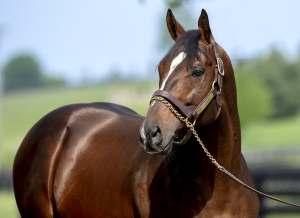 Bronze: PRESERVATIONIST (Arch-Flying Dixie by Dixieland Band) Airdrie, $10,000
Bronze: PRESERVATIONIST (Arch-Flying Dixie by Dixieland Band) Airdrie, $10,000 Will Take Charge (Unbridled's Song) and Take Charge Indy (A.P. Indy), their dam Take Charge Lady (Dehere) herself a multiple elite scorer. He also doubles up War Front's damsire Rubiano behind his third dam. We know how Rubiano's half-sister gave us a monster dirt influence in Tapit, while the other three sires seeding the bottom half of Omaha Beach's third generation are Raise A Native, Buckpasser and Deputy Minister.
Will Take Charge (Unbridled's Song) and Take Charge Indy (A.P. Indy), their dam Take Charge Lady (Dehere) herself a multiple elite scorer. He also doubles up War Front's damsire Rubiano behind his third dam. We know how Rubiano's half-sister gave us a monster dirt influence in Tapit, while the other three sires seeding the bottom half of Omaha Beach's third generation are Raise A Native, Buckpasser and Deputy Minister.